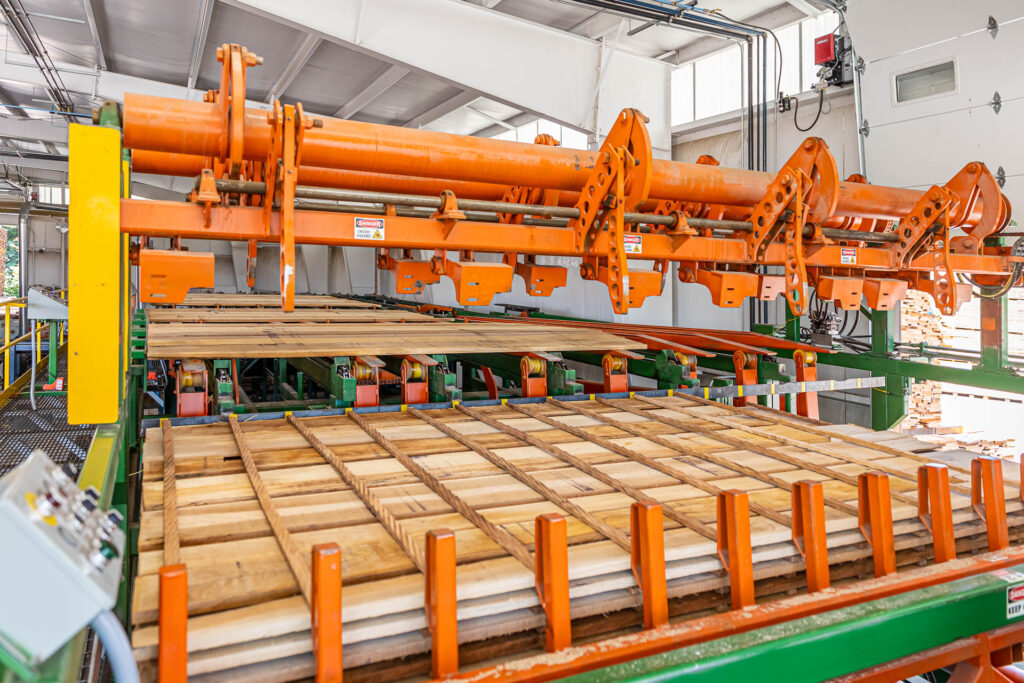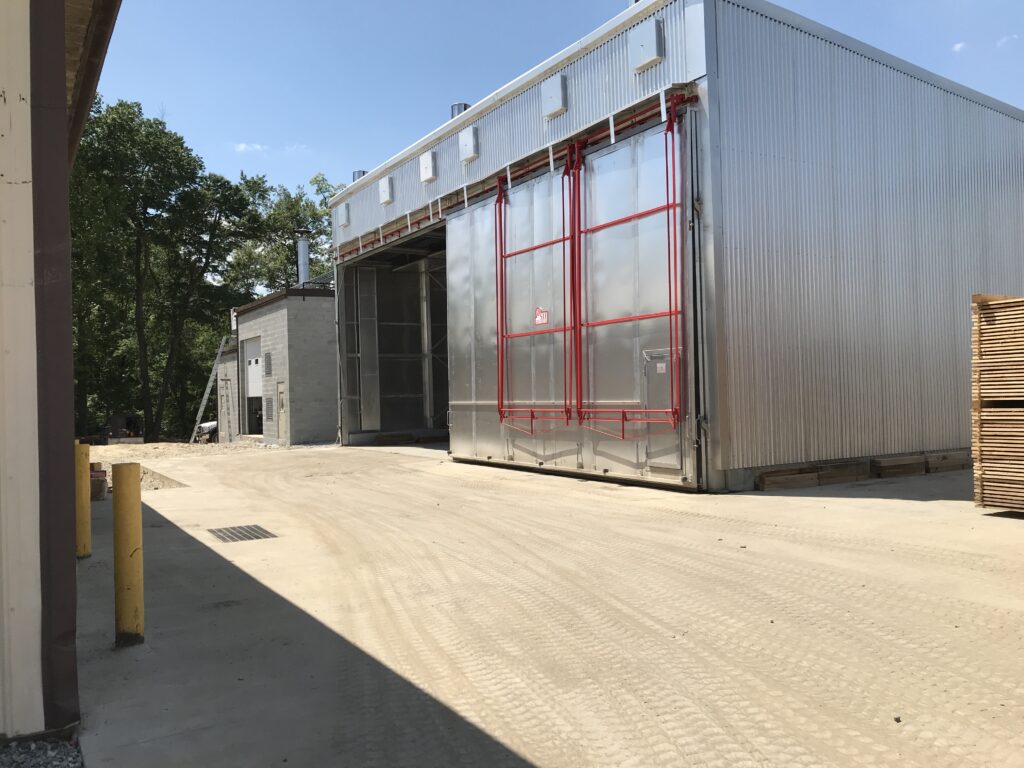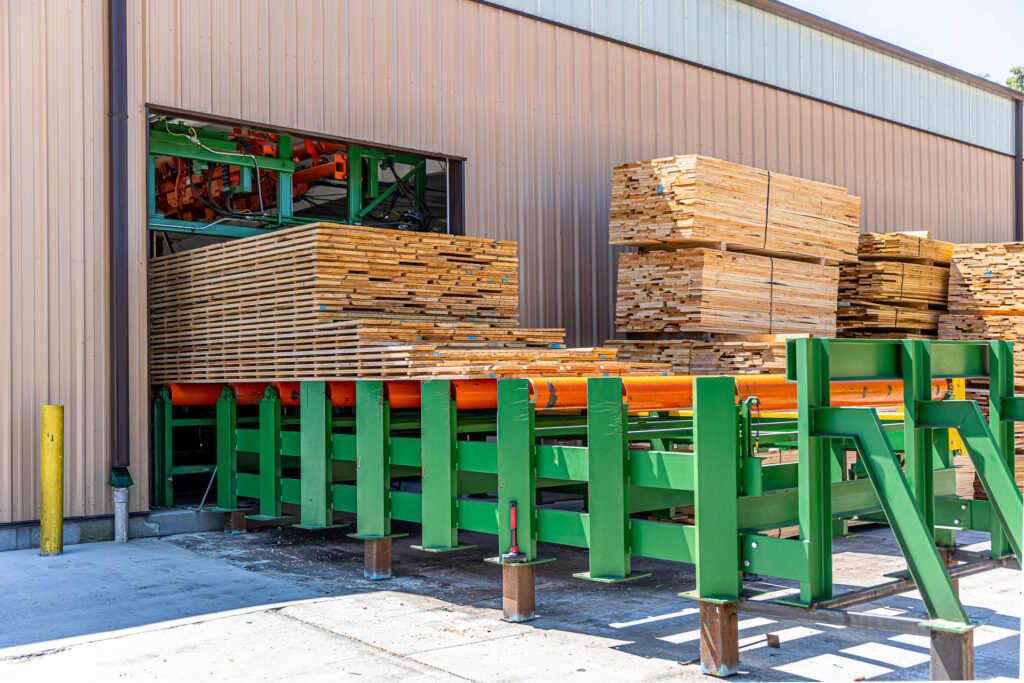Introduction
Last winter, we covered the details of a Stoltzfus timber harvest, and several months ago, we toured our sawmill. But there is one more step in producing quality lumber, and that’s the focus of this article.
Of the many species we cut in the woods, only seven are part of our hardwood lumber line. The rest don’t go to waste. They go into secondary products like shipping pallets and heavy-equipment cribbing.
The seven premier woods are:
| Soft Maple | Red Oak | Hickory | Poplar |
| White Oak | Cherry | Walnut |
Each of these woods goes through a carefully-ordered drying and bundling process. The process varies from species to species and season to season, but the general steps are the same:
- Post-mill processing
- Drying
- Regrading and warehousing
Post-mill processing
Before wood leaves the sawmill, we grade and sort the boards and load them onto carts. Once the carts are full, we bring them to our dry storage building, where a group of six workers prepare the wood for drying.
Inside the dry storage building, the boards are placed onto a conveyor one layer at a time (each layer is 7’ wide). The conveyor advances the boards, and three workers place strips of wood on top of (and perpendicular to) them. These strips, called stickers, contain grooves that allow air to the boards as they dry (this helps avoid stains). The stickers are placed a foot apart. Once a layer is completely stickered, we repeat the process with another layer and continue to do so until our stacks are about 25 boards high.
Once we have a full stack, the boards leave the dry storage room and are taken out for drying.

Drying
Every wood is different and requires careful handling for best results. Seasonal weather also affects the process. Despite these varying conditions, most wood is partially air-dried before we place it in a kiln.
Air drying
It may be obvious, but air-drying occurs outdoors. We do keep the stacks under roof to avoid rain damage. Though air drying is slower than kiln drying and is not adequate by itself, it is an important part of making quality lumber. The more we can air-dry a stack, the less time it needs to be in the kiln. Air drying allows us to process greater amounts of lumber while minimizing our heating costs.
Some species must be placed into the kilns within a short time of milling. For example, soft maple and poplar will stain if air-dried for any length of time.
On the other hand, oak spends the longest time air drying. But even with air drying, if we are not careful, oak will dry too quickly and check or crack as it dries. To avoid this, we often wet the board ends to prevent rapid drying. In addition, oak that isn’t air-dried can tie up the kilns for two months. This is why oak spends the longest time outdoors.
Kiln
After an appropriate time outdoors, we move lumber into one of our three kilns.
Two kilns measure 24×30, with an interior tall enough for a stack 22’ tall. These are classed as 30k-board-foot kilns, but we can often get 40k feet or more in at a time. At 30×30, the third kiln is larger. It is rated for 50k board feet, but we typically load it with even more wood than that.
We monitor kiln conditions and adjust them frequently. Like oak, any wood that is dried too quickly will check or crack. But, if dried too slowly, wood will warp or mold.
Kiln temperatures depend on species and vary throughout the drying process. The following are some examples of the process:
| Species | Typical Start Temp. | Typical Finish Temp. | Typical Days in Kiln |
| Oak | 85 | 160 | 30 |
| Poplar | 130 | 140 | 6 |
| Walnut | 120 | 160 | 14 |
Oak, because it releases moisture slowly, is challenging to dry. Since the outside dries faster than the inside, boards are prone to developing tension. We monitor this by cutting small samples from the boards. If tension develops, we use steam to add moisture back into the kiln. This moistens and relaxes the outer part of the board until the interior finishes drying.
Once the wood has reached 6-8% moisture, we remove it from the kiln for final processing.

Post-kiln
After leaving the kiln, lumber returns to the dry storage building for another careful inspection and grading. Earlier, in the milling phase, we focused on speed and efficiency while striving for quality. Now, our sole focus is on quality, even if it costs us time.
De-stickering and regrading
We bring the stacks into the warehouse and, layer by layer, remove the stickers from between the boards. While doing so, we also make a careful final inspection and regrade the boards if necessary.
Although we use NHLA (National Hardwood Lumber Association) standards as a guide, there are times when our standards are even higher. If we find a board that we believe would disappoint our customer, we pull it out. If we can solve the problem by cutting out a bad spot, we will turn one board into two. Otherwise, we will degrade the board.
During this final phase, we width-sort the boards. Additionally, if a customer has requested special milling or planing, we do this before stacking and strapping. After this, boards go into our long-term storage or distribution area or are set aside for local delivery or customer pickup.

Conclusion
Because we control wood production from beginning to end, we can maintain tight quality controls. Our foresters mark the trees, our loggers cut them, and then our mill and kiln crews turn them into the premier lumber that you depend on.
If you have any more questions about our operation or our goals, please call us. We’ll be happy to speak with you.